Compare Attentive, Klaviyo, and Maestra across SMS, email, loyalty, personalization, push, reporting, and pricing. Discover which platform fits your e-commerce growth strategy in 2025
Attentive vs Klaviyo vs Maestra: Choosing Your Ideal E‑Commerce Marketing Platform
Attentive and Klaviyo excel in different areas for e-commerce marketers. Here’s how they cater to specific business needs and use cases:
Attentive—Best for: Established brands (often mid-sized or larger) that want to maximize SMS marketing (with a side of email) and benefit from hands-on guidance.
Attentive’s core strength is text message marketing: it pioneered SMS for e-commerce and offers two-way conversational texting via its “Concierge” AI feature.
However, Attentive’s focus is narrow—beyond SMS and basic email, it lacks built-in loyalty programs, web personalization, or push notifications. This means you’ll likely need additional tools to cover other channels, and its higher price can be a hurdle for smaller businesses.
Klaviyo—Best for: Small and mid-sized online businesses (especially Shopify stores) seeking an easy-to-use email and SMS solution with deep e-commerce integration.
Klaviyo’s strength lies in its rich email/SMS automation and segmentation tied to store data. It offers a library of pre-built flows (welcome series, cart recovery, etc.) that you can launch in minutes, and it automatically pulls in product and purchase data for personalization. Klaviyo is relatively affordable to start (includes a free tier) and provides quick ROI for standard email/SMS campaigns.
However, Klaviyo is less comprehensive outside those two channels—it does not support on-site personalization or loyalty natively, and has only recently added basic mobile push (no web push). As your marketing becomes more advanced, you may outgrow Klaviyo or need to bolt on extra tools for things like on-site promos, advanced 1:1 personalization, or multi-channel attribution.
Neither Attentive nor Klaviyo include a true built-in customer data platform or native loyalty features, so personalized omnichannel marketing can be challenging on those tools. They also tend to offer one-on-one strategic support only to their largest customers—smaller teams must rely on standard support or self-serve resources.
These limitations often lead to a fragmented marketing stack (and higher total costs) once you need capabilities beyond the basics.
That’s why we included Maestra in this comparison. It’s the most unified platform of the three, designed to eliminate those gaps
Maestra—Best for: Mid-market and growing e-commerce brands with an established marketing team who are ready for a unified platform to drive hyper-personalized promotions across all channels.
Maestra is an all-in-one solution that combines real-time customer data, omnichannel automation, loyalty/rewards, and personalization in one place. Instead of piecing together multiple tools, Maestra lets you run everything—email, SMS, website personalization, mobile/web push, product recommendations, loyalty programs, ad retargeting—from a single hub. The result is seamless 1:1 experiences. This platform delivers enterprise-level capabilities without requiring a big technical team, and every client gets a dedicated success manager to assist with strategy and support.
In this in-depth comparison, we’ll evaluate Attentive vs Klaviyo vs Maestra on all the key areas e-commerce marketers care about.
Content:
Comparison Summary Table
Feature
Attentive
Klaviyo
Maestra
Omnichannel Flows
⭐⭐⭐
Supports basic automation primarily for SMS and email, lacks true cross-channel coordination
Supports basic automation primarily for SMS and email, lacks true cross-channel coordination
⭐⭐⭐⭐
Effective email and SMS flows with visual builder, limited to these two channels and basic push
Effective email and SMS flows with visual builder, limited to these two channels and basic push
🏆
⭐⭐⭐⭐⭐
Fully integrated omnichannel automation across email, SMS, push, web personalization, and more in real-time
⭐⭐⭐⭐⭐
Fully integrated omnichannel automation across email, SMS, push, web personalization, and more in real-time
Customer Data Management & Segmentation
⭐⭐
Basic segmentation using limited attributes and behaviors, lacking a full customer data platform
Basic segmentation using limited attributes and behaviors, lacking a full customer data platform
⭐⭐⭐⭐
Robust segmentation leveraging rich e-commerce purchase and browsing data, not fully real-time
Robust segmentation leveraging rich e-commerce purchase and browsing data, not fully real-time
🏆
⭐⭐⭐⭐⭐
Advanced real-time segmentation based on comprehensive online and offline unified customer data
⭐⭐⭐⭐⭐
Advanced real-time segmentation based on comprehensive online and offline unified customer data
Site Personalization
⭐
Minimal site interaction beyond basic pop-ups, lacks dynamic personalization capabilities
Minimal site interaction beyond basic pop-ups, lacks dynamic personalization capabilities
⭐
Limited to basic website forms and pop-ups without true personalization
Limited to basic website forms and pop-ups without true personalization
🏆
⭐⭐⭐⭐⭐
Dynamic, real-time content and personalized experiences tailored to individual user behavior across the entire website
⭐⭐⭐⭐⭐
Dynamic, real-time content and personalized experiences tailored to individual user behavior across the entire website
Email Marketing
⭐⭐⭐
Basic email creation and automation capabilities suitable for straightforward campaigns, limited advanced functionality
Basic email creation and automation capabilities suitable for straightforward campaigns, limited advanced functionality
⭐⭐⭐⭐
Comprehensive email features including advanced automation, rich template library, and strong integration with e-commerce platforms
Comprehensive email features including advanced automation, rich template library, and strong integration with e-commerce platforms
🏆
⭐⭐⭐⭐⭐
Advanced email personalization, dynamic content blocks, high deliverability, and enterprise-level email capabilities fully integrated with customer data
⭐⭐⭐⭐⭐
Advanced email personalization, dynamic content blocks, high deliverability, and enterprise-level email capabilities fully integrated with customer data
SMS Marketing
🏆
⭐⭐⭐⭐⭐
Leading capabilities including AI-powered conversational SMS, compliance tools, and two-way communication
⭐⭐⭐⭐⭐
Leading capabilities including AI-powered conversational SMS, compliance tools, and two-way communication
⭐⭐⭐⭐
Strong and well-integrated SMS capabilities, useful for standard automation flows, limited conversational features
Strong and well-integrated SMS capabilities, useful for standard automation flows, limited conversational features
🏆
⭐⭐⭐⭐⭐
Advanced SMS integrated into omnichannel workflows, supports sophisticated personalization and intelligent cross-channel coordination
⭐⭐⭐⭐⭐
Advanced SMS integrated into omnichannel workflows, supports sophisticated personalization and intelligent cross-channel coordination
Website & Email Product Recommendations
⭐
No native product recommendation functionality, manual selection required
No native product recommendation functionality, manual selection required
⭐⭐
Basic product recommendation blocks in emails based on simple rules and product popularity
Basic product recommendation blocks in emails based on simple rules and product popularity
🏆
⭐⭐⭐⭐⭐
AI-driven recommendations dynamically personalized to each customer, across both website and email channels, continuously optimized
⭐⭐⭐⭐⭐
AI-driven recommendations dynamically personalized to each customer, across both website and email channels, continuously optimized
Promotions and Referrals
⭐⭐
Limited to basic coupon delivery via SMS/email, requires external tools for advanced promotions or referral tracking
Limited to basic coupon delivery via SMS/email, requires external tools for advanced promotions or referral tracking
⭐⭐
Basic promotion functionality with coupon integration, lacks native referral program management
Basic promotion functionality with coupon integration, lacks native referral program management
🏆
⭐⭐⭐⭐⭐
Comprehensive promotion and referral management, including automated tracking, rewards, and dynamic campaigns fully integrated across channels
⭐⭐⭐⭐⭐
Comprehensive promotion and referral management, including automated tracking, rewards, and dynamic campaigns fully integrated across channels
Loyalty Programs
⭐
No built-in loyalty management features, requires external loyalty tools
No built-in loyalty management features, requires external loyalty tools
⭐
Lacks native loyalty features, relies entirely on third-party integrations for loyalty management
Lacks native loyalty features, relies entirely on third-party integrations for loyalty management
🏆
⭐⭐⭐⭐⭐
Fully integrated loyalty program management including points, tiers, rewards, and automated personalized engagement
⭐⭐⭐⭐⭐
Fully integrated loyalty program management including points, tiers, rewards, and automated personalized engagement
Mobile & Web Push Notifications
⭐
No support for mobile or web push notifications
No support for mobile or web push notifications
⭐⭐⭐
Supports basic mobile app push notifications with recent integration, no support for web push notifications
Supports basic mobile app push notifications with recent integration, no support for web push notifications
🏆
⭐⭐⭐⭐⭐
Comprehensive push notification capabilities including both mobile app and web browser push, integrated into omnichannel customer journeys
⭐⭐⭐⭐⭐
Comprehensive push notification capabilities including both mobile app and web browser push, integrated into omnichannel customer journeys
Ad Optimization
⭐⭐
Limited capability requiring manual export of segments to ad platforms, minimal integration
Limited capability requiring manual export of segments to ad platforms, minimal integration
⭐⭐⭐⭐
Good integration with Facebook and Google for automated segment syncing, effective for retargeting campaigns
Good integration with Facebook and Google for automated segment syncing, effective for retargeting campaigns
🏆
⭐⭐⭐⭐⭐
Automated, dynamic ad audience optimization leveraging real-time behavior, integrated seamlessly into overall marketing strategies
⭐⭐⭐⭐⭐
Automated, dynamic ad audience optimization leveraging real-time behavior, integrated seamlessly into overall marketing strategies
Reporting & Attribution
⭐⭐⭐
Channel-specific reporting primarily for SMS and email with basic conversion tracking
Channel-specific reporting primarily for SMS and email with basic conversion tracking
⭐⭐⭐⭐
Solid reporting for email/SMS campaigns with clear revenue attribution, lacks extensive multi-channel attribution
Solid reporting for email/SMS campaigns with clear revenue attribution, lacks extensive multi-channel attribution
🏆
⭐⭐⭐⭐⭐
Comprehensive, cross-channel analytics and attribution, supporting advanced reporting like control groups and multi-touch attribution models
⭐⭐⭐⭐⭐
Comprehensive, cross-channel analytics and attribution, supporting advanced reporting like control groups and multi-touch attribution models
Customer Support
⭐⭐⭐⭐
Good quality support that varies significantly based on customer size, larger customers receive more personalized service
Good quality support that varies significantly based on customer size, larger customers receive more personalized service
⭐⭐⭐
Standard support primarily through documentation and community forums, dedicated account management limited to large clients
Standard support primarily through documentation and community forums, dedicated account management limited to large clients
🏆
⭐⭐⭐⭐⭐
High-touch, personalized white-glove support provided to every client, including dedicated customer success managers and strategic guidance
⭐⭐⭐⭐⭐
High-touch, personalized white-glove support provided to every client, including dedicated customer success managers and strategic guidance
Integration Capabilities
⭐⭐⭐⭐
Standard e-commerce platform integrations available, some custom development may be required
Standard e-commerce platform integrations available, some custom development may be required
🏆
⭐⭐⭐⭐⭐
Extensive library of plug-and-play integrations with major e-commerce and marketing platforms, easily accessible without coding
⭐⭐⭐⭐⭐
Extensive library of plug-and-play integrations with major e-commerce and marketing platforms, easily accessible without coding
🏆
⭐⭐⭐⭐⭐
Flexible integration capabilities, including both pre-built connectors and bespoke integration solutions actively supported by the provider
⭐⭐⭐⭐⭐
Flexible integration capabilities, including both pre-built connectors and bespoke integration solutions actively supported by the provider
Educational Resources
⭐⭐⭐⭐
Useful, focused educational resources on SMS marketing, lacks extensive structured training programs
Useful, focused educational resources on SMS marketing, lacks extensive structured training programs
🏆
⭐⭐⭐⭐⭐
Comprehensive educational resources including Klaviyo Academy, certification programs, and vibrant community forums
⭐⭐⭐⭐⭐
Comprehensive educational resources including Klaviyo Academy, certification programs, and vibrant community forums
🏆
⭐⭐⭐⭐⭐
Personalized onboarding, dedicated training sessions with success managers, extensive knowledge base and tailored resources
⭐⭐⭐⭐⭐
Personalized onboarding, dedicated training sessions with success managers, extensive knowledge base and tailored resources
Pricing
💲💲
Negotiated rates based on usage, potentially premium cost at scale
Negotiated rates based on usage, potentially premium cost at scale
💲
Transparent pricing model scaling clearly with number of contacts and SMS volume, affordable at small scale
Transparent pricing model scaling clearly with number of contacts and SMS volume, affordable at small scale
💲💲
Fixed, inclusive pricing tiers based on customer profile volume, comprehensive feature set and dedicated service included
Fixed, inclusive pricing tiers based on customer profile volume, comprehensive feature set and dedicated service included
Attentive vs Klaviyo vs Maestra: Omnichannel Flows
Attentive
Klaviyo
Maestra
⭐⭐⭐
Supports basic automation primarily for SMS and email, lacks true cross-channel coordination
Supports basic automation primarily for SMS and email, lacks true cross-channel coordination
⭐⭐⭐⭐
Effective email and SMS flows with visual builder, limited to these two channels and basic push
Effective email and SMS flows with visual builder, limited to these two channels and basic push
⭐⭐⭐⭐⭐
Fully integrated omnichannel automation across email, SMS, push, web personalization, and more in real-time
Fully integrated omnichannel automation across email, SMS, push, web personalization, and more in real-time
Attentive lets you set up automated texts (and emails) for events like sign-ups or cart abandonments, but since it doesn’t cover channels like push or on-site, its flows are inherently limited in channel scope.
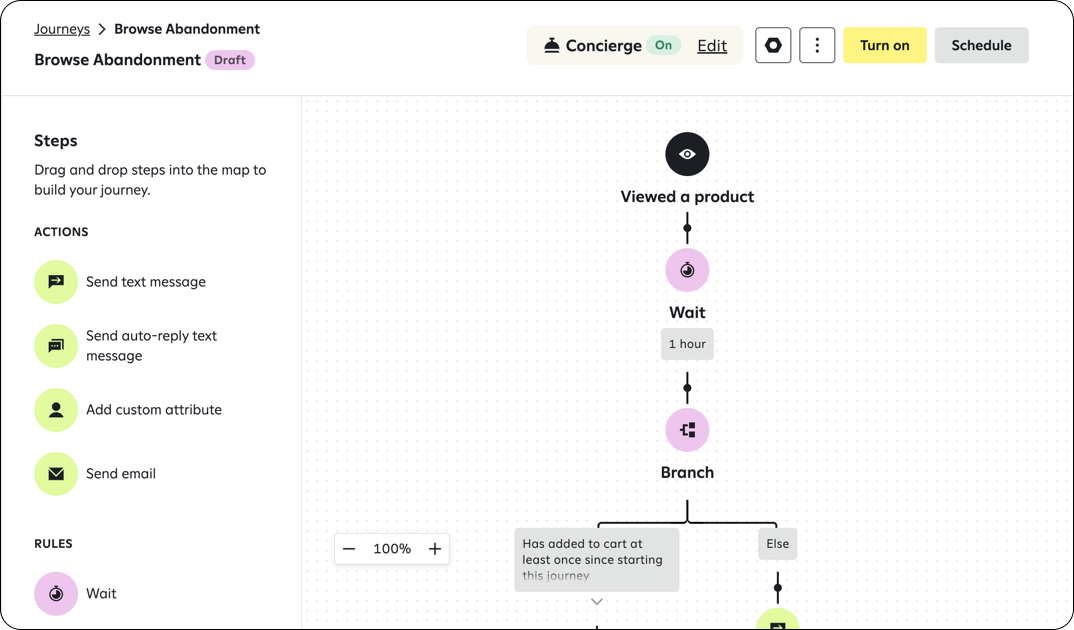
Attentive‘s journey builder
Klaviyo provides a visual flow builder where you can mix email and SMS steps easily—for example, an abandoned cart flow might email first, then text as a follow-up. It recently added mobile push into the mix for those with an app.
However, Klaviyo still lacks other touchpoints (no native web personalization actions in flows, etc.), so you can’t fully orchestrate every channel in one Klaviyo flow.

Klaviyo’s flow builder
Maestra stands out by enabling truly omnichannel journeys: you can create a single flow that might start with an email, then trigger an on-site popup, then an SMS, then a push notification—all based on real-time customer behavior.
Because Maestra has a built-in CDP, the flow can branch intelligently (e.g. “if customer purchased in store, skip the next email”) in ways Attentive and Klaviyo can’t.

Maestra’s flow example: abandoned card flow with emails, mobile and web pushes, pop-ups, paid ads and loyalty points
In short, Attentive and Klaviyo are effective for two-channel automation, but Maestra is built for orchestrating all channels together. If your goal is a cohesive omnichannel customer journey, Maestra provides the canvas to do it, whereas with Attentive/Klaviyo you’d be juggling additional tools for other channels.
Omnichannel Flows Winner: Maestra
Maestra delivers seamless, omnichannel flows by letting you orchestrate every channel in one place with unified data. Attentive and Klaviyo both limit you to email/SMS, which is fine for basic campaigns but falls short of true omnichannel personalization.
With Maestra, a customer’s actions on any channel can automatically shape the next touchpoint across all channels—something neither Attentive nor Klaviyo can natively achieve. For a brand aiming to engage customers in a coordinated way via email, text, web, app, and ads, Maestra is the clear choice.
Attentive vs Klaviyo vs Maestra: Customer Data Management & Segmentation
Attentive
Klaviyo
Maestra
⭐⭐
Attentive stores basic customer profiles (email, phone) and tracks e-commerce events through integrations. You can segment users by attributes or behavior, but it’s not a full CDP. Advanced metrics like lifetime value or predictive scores aren’t native.
Attentive stores basic customer profiles (email, phone) and tracks e-commerce events through integrations. You can segment users by attributes or behavior, but it’s not a full CDP. Advanced metrics like lifetime value or predictive scores aren’t native.
⭐⭐⭐⭐
Klaviyo auto-syncs rich e-commerce data into unified profiles, enabling powerful segmentation. Its engine supports extensive behavior and trait combinations but segments aren’t updated in real-time across all channels.
Klaviyo auto-syncs rich e-commerce data into unified profiles, enabling powerful segmentation. Its engine supports extensive behavior and trait combinations but segments aren’t updated in real-time across all channels.
⭐⭐⭐⭐⭐
Maestra unifies online and offline data into real-time profiles and instantly updates segments based on behavior. Extremely granular segments can be created and used across campaigns, ensuring precise 1:1 personalization at scale.
Maestra unifies online and offline data into real-time profiles and instantly updates segments based on behavior. Extremely granular segments can be created and used across campaigns, ensuring precise 1:1 personalization at scale.
Attentive and Klaviyo integrate with e-commerce platforms to pull in customer and order data, but they handle that data differently.
Attentive focuses on data relevant to SMS/email campaigns—e.g., it will log subscriber attributes and events like products viewed or items added to cart (if your site is integrated) to allow segmenting who to text. You can create segments in Attentive (say, “VIP customers” or “Browsed category X”) to target messages, but Attentive doesn’t serve as a full database of all customer touchpoints. There’s no advanced attribution of offline data, and no built-in predictive segmentation.
Klaviyo, on the other hand, essentially acts as a mini customer data hub for online stores. It automatically records each customer’s browsing, purchasing, and engagement history, and you can build very granular segments using that info. Klaviyo even introduced predictive analytics (customer lifetime value, churn probability) for larger accounts, approaching CDP-like functionality.
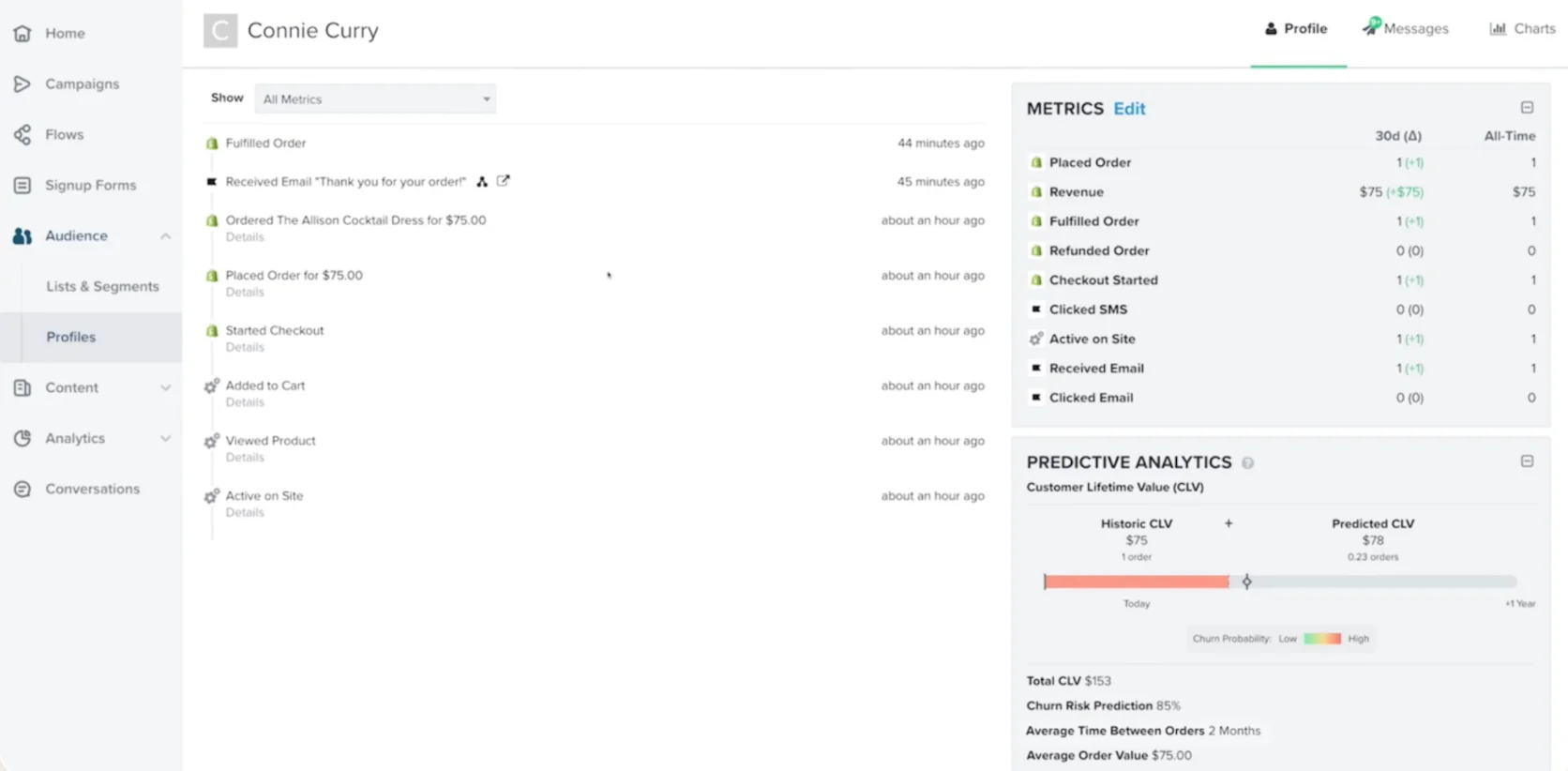
Customer profile in Klaviyo
The main limitation is that Klaviyo’s data is mostly what happens online/in emails—if you have offline purchases or other data, you might need to import it. Also, Klaviyo’s segments update quickly but not in true real-time across channels.
Maestra is built on a real-time CDP (Customer Data Platform), meaning it ingests data from all sources (online, offline, POS, loyalty, etc.) and updates instantly.
This allows extremely fine segmentation—for example, you could target in-store shoppers who haven’t bought online in 3 months and have $200+ in loyalty points. Every piece of data is usable in segmentation, and because it’s all under one roof, those segments fuel personalization everywhere.
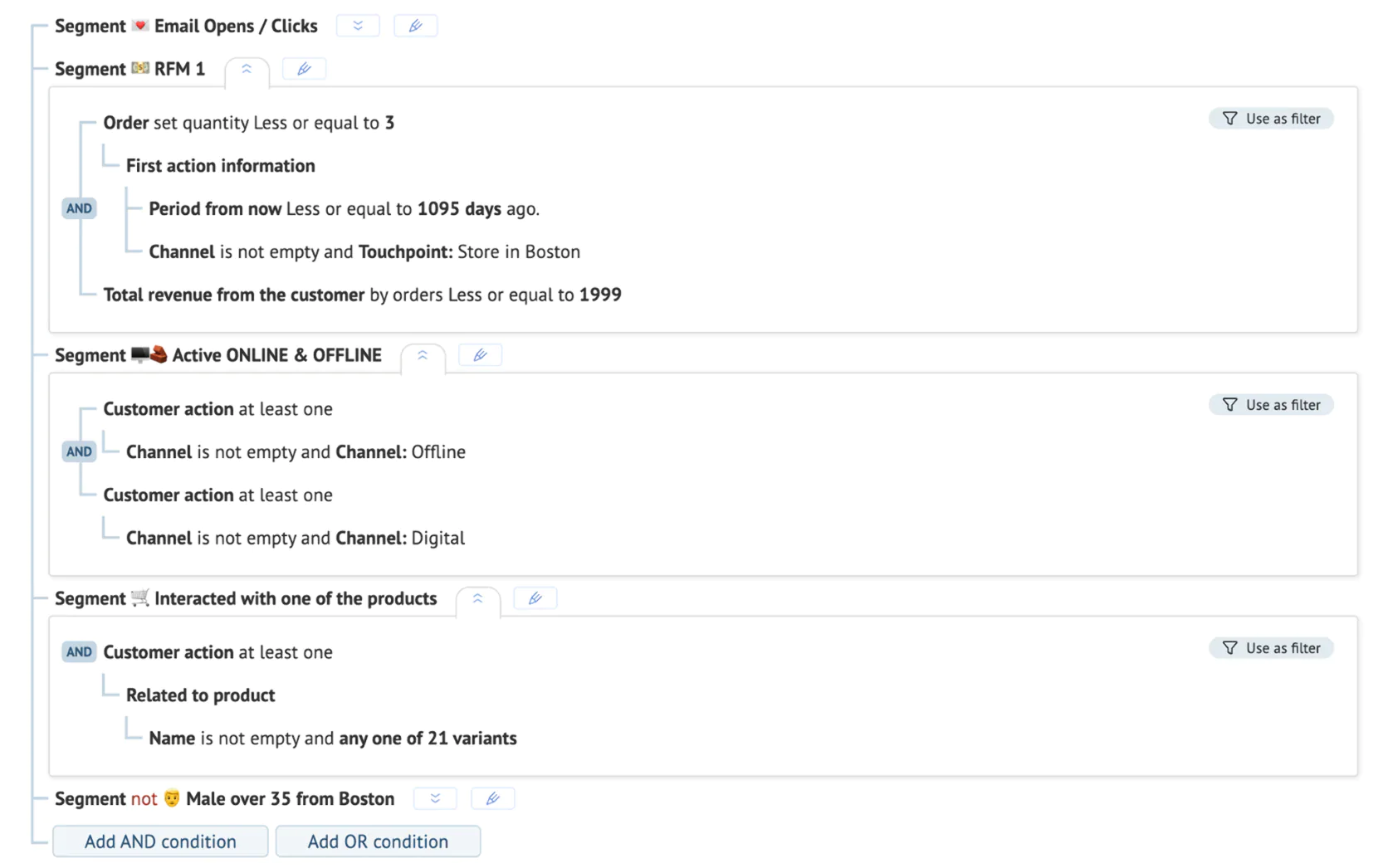
Maestra: user segmentation
In summary: Attentive = basic segmentation within SMS/email context; Klaviyo = advanced segmentation within the e-commerce context; Maestra = advanced segmentation across all contexts with real-time updates.
Customer Data Management & Segmentation Winner: Maestra
Maestra wins with its integrated, real-time CDP and powerful segmentation built for commerce. It gives you a single source of truth for each customer and the tools to slice audiences in any way imaginable (and have those segments update instantly).
Klaviyo comes second—it has excellent segmentation using e-commerce data, which is sufficient for many mid-tier needs.
Attentive lags here; while you can segment SMS audiences, it doesn’t approach the depth or real-time unification that Maestra offers.
For data-centric marketing (think personalized campaigns based on detailed customer behavior), Maestra provides the strongest foundation.
Attentive vs Klaviyo vs Maestra: Site Personalization
Attentive
Klaviyo
Maestra
⭐
No native on-site personalization features beyond basic pop-ups.
No native on-site personalization features beyond basic pop-ups.
⭐
Minimal on-site personalization limited to basic pop-ups and forms. True tailored experiences require external tools.
Minimal on-site personalization limited to basic pop-ups and forms. True tailored experiences require external tools.
⭐⭐⭐⭐⭐
Maestra provides dynamic real-time site personalization, modifying website content for individual visitors based on segments or behavior, creating uniquely individualized experiences.
Maestra provides dynamic real-time site personalization, modifying website content for individual visitors based on segments or behavior, creating uniquely individualized experiences.
When it comes to personalizing the on-site experience (your website content tailored per visitor), Attentive and Klaviyo have minimal capabilities.
Attentive primarily offers tools to capture data on your site (like pop-ups to collect SMS/email signups) but not to change the content a user sees beyond maybe a personalized coupon code in a pop-up. There’s no feature in Attentive to say “show product recommendations on the homepage for this user” or swap out banners based on segment.
Klaviyo is similarly limited on-site. Its new initiatives (like a customer profile portal or basic product rec blocks for websites) are very rudimentary and not widely rolled out. In practice, Klaviyo personalizes via email/SMS; on the web, you’d use Shopify’s personalization or a third-party tool if you want dynamic content.
Maestra was built to bridge that gap. It has an in-session personalization engine that can alter your website or mobile app content in real time according to the visitor’s data.
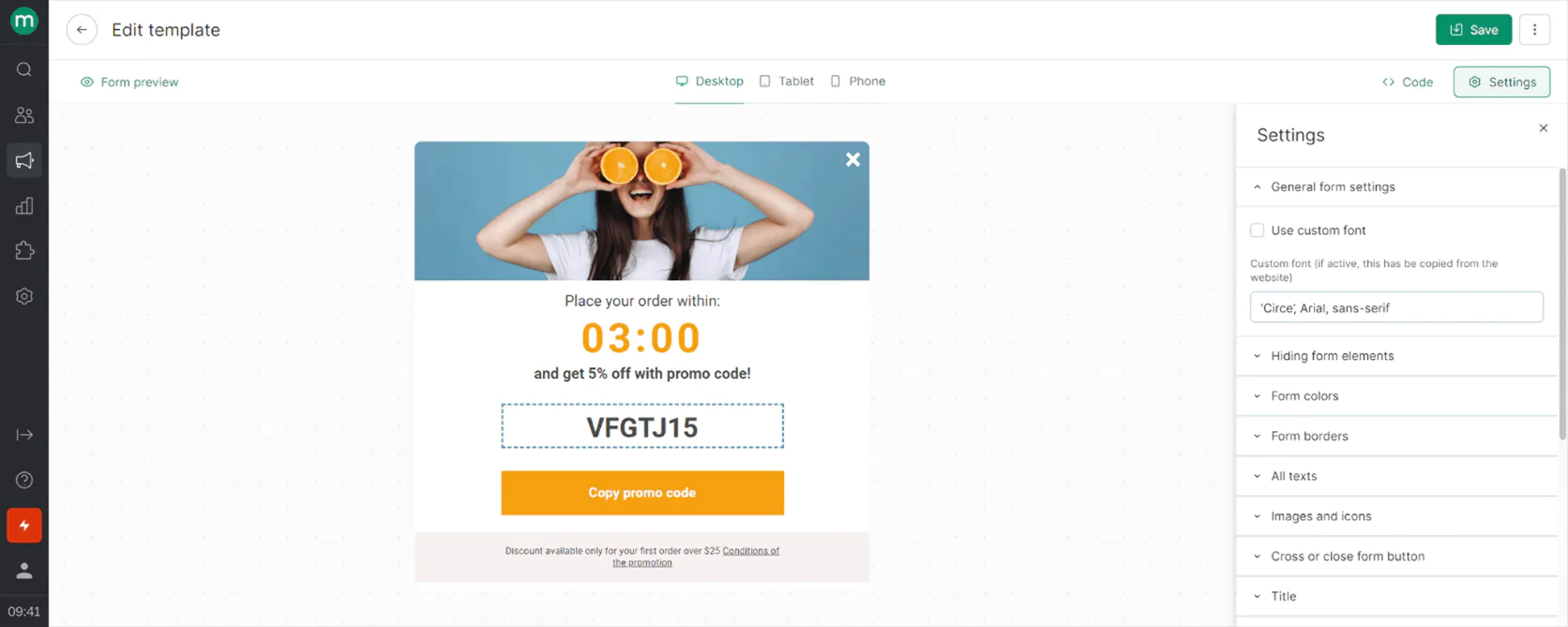
Maestra’s pop-up template editing
For example, a first-time visitor might see a “10% off your first purchase” banner, while a returning loyal customer sees a “Welcome back, [Name]! You have 200 points” banner. You can change images, text, product sorting, and more—all based on Maestra’s segments and triggers.
This level of web/app personalization is something neither Attentive nor Klaviyo offer natively. If on-site conversion optimization through personalized content is important, Maestra provides that out of the box; with Attentive or Klaviyo, you’d need an add-on service or custom development to achieve similar results.
Site Personalization Winner: Maestra
Maestra provides the most robust site personalization—it’s like having a personalization engine built into your marketing platform. You can deliver individualized experiences on your homepage, product pages, etc., without coding, all driven by Maestra’s real-time data.
Attentive and Klaviyo don’t offer dynamic site content personalization at all (aside from basic pop-ups), which means they can’t adapt the on-site experience per user.
For tailoring your website to each customer, Maestra is in a league of its own in this comparison.
Attentive vs Klaviyo vs Maestra: Email Marketing
Attentive
Klaviyo
Maestra
⭐⭐⭐
Attentive provides basic email capabilities suitable for simple campaigns, but lacks advanced features compared to dedicated platforms.
Attentive provides basic email capabilities suitable for simple campaigns, but lacks advanced features compared to dedicated platforms.
⭐⭐⭐⭐
Klaviyo excels with comprehensive email marketing capabilities, deep store integration, automation, and personalization. Slight limitations in advanced personalization exist without a built-in CDP.
Klaviyo excels with comprehensive email marketing capabilities, deep store integration, automation, and personalization. Slight limitations in advanced personalization exist without a built-in CDP.
⭐⭐⭐⭐⭐
Maestra offers advanced email personalization, dynamic content, robust deliverability, and enterprise-grade email features fully integrated with customer data.
Maestra offers advanced email personalization, dynamic content, robust deliverability, and enterprise-grade email features fully integrated with customer data.
All three platforms can send marketing emails, but their email capabilities differ in depth.
Attentive added email relatively recently by acquiring Privy, so its email tool covers the basics: you can compose emails (with a simple editor), send broadcasts, and set up a few automated email sequences.
This is convenient if you want one platform for both SMS and email, but keep in mind Attentive’s heritage is SMS—its email lacks some advanced features (e.g. sophisticated template design, spam testing, deliverability analytics that dedicated email providers have). It’s perfectly fine for straightforward campaigns, but power users might find it limiting.
Klaviyo, conversely, is often considered one of the gold standards in e-commerce email. It has a very user-friendly drag-drop email builder with a large template library, making it easy to create professional emails. It automatically handles things like abandoned cart emails with product info, because it’s tightly integrated with your store data.

Klaviyo’s email composer
Additionally, Klaviyo gives you detailed metrics on each email and has features like smart sending (to avoid over-emailing) and segmentation within campaigns.
The only knocks on Klaviyo’s email might be that extremely advanced personalization or complex layouts could require custom coding—and huge send volumes might incur additional cost—but for the majority of use cases, Klaviyo email is excellent.
Maestra’s email capabilities are designed to be enterprise-grade. It has its own email template builder focused on generating lean code (so your emails don’t clip in Gmail).
Maestra also incorporates dynamic content blocks, meaning sections of an email can change based on the recipient’s attributes (without you having to create separate versions). For example, one email campaign can show a high-tier loyalty customer a VIP offer block, while a regular customer sees a generic block—all automatically.

Maestra’s visual email composer
Additionally, Maestra provides advanced testing (A/B and even multivariate on email content) and detailed deliverability tools.
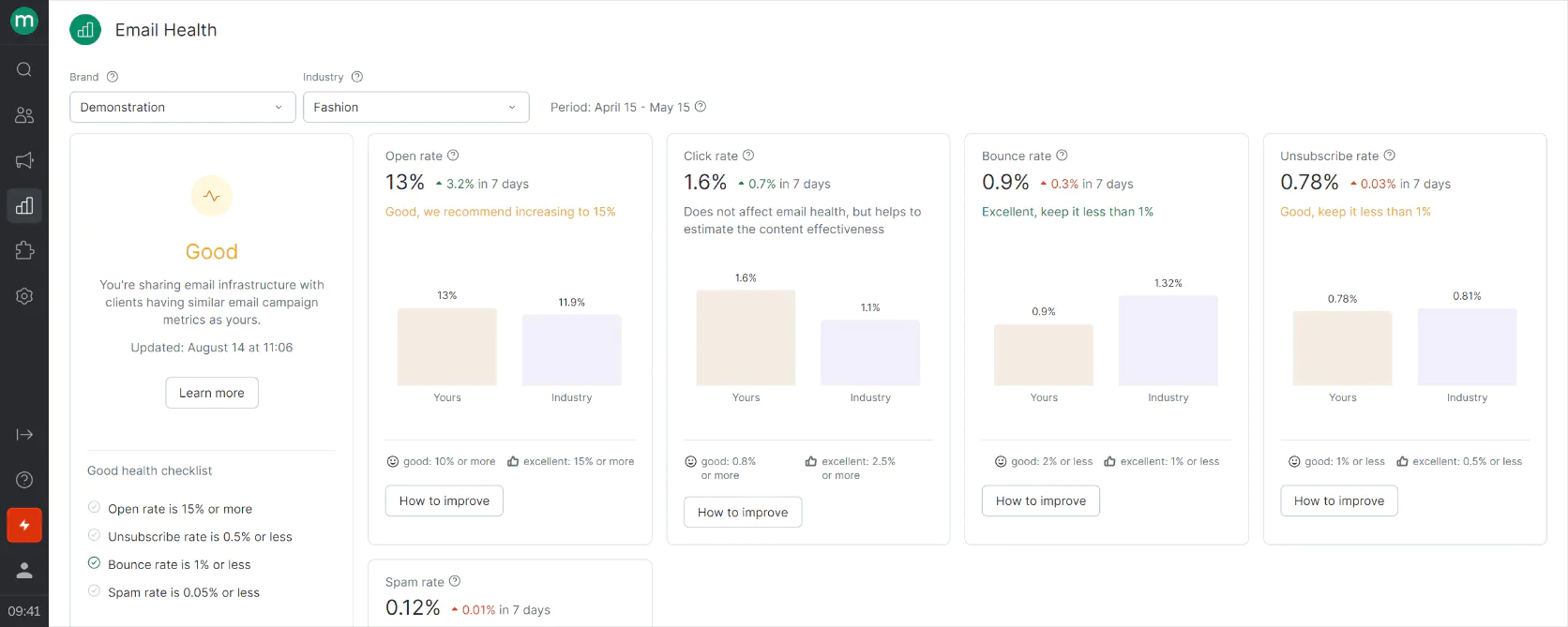
Maestra’s email health monitoring
With sending capacity engineered for large lists and all features included (no sending cap aside from your plan’s profile count), Maestra’s email is on par with dedicated email marketing services used by big retailers.
In essence: Attentive = basic but handy email option, Klaviyo = comprehensive e-commerce email solution, Maestra = advanced personalized email as part of an omnichannel strategy.
Email Winner: Maestra
Klaviyo is often praised for email because it’s easy and built for e-commerce—that remains true, especially for small teams getting started. If you want quick wins and solid out-of-the-box flows, Klaviyo email is fantastic.
However, Maestra edges out as the winner for email in this comparison due to its greater personalization and scale. Maestra lets you personalize emails using any data point (not just simple merge tags), and automate dynamic content in ways Klaviyo can’t without external help.
It also integrates email into the larger customer journey seamlessly (e.g. pausing emails if a user buys in-store). Attentive’s email, while a nice add-on for SMS-focused clients, isn’t robust enough to challenge the other two.
So, for the most impactful email marketing—especially if you plan to segment deeply and send at scale—Maestra provides the most capabilities and flexibility.
Attentive vs Klaviyo vs Maestra: SMS Marketing
Attentive
Klaviyo
Maestra
⭐⭐⭐⭐⭐
Attentive excels at SMS with advanced features like conversational AI, MMS support, and robust compliance tools.
Attentive excels at SMS with advanced features like conversational AI, MMS support, and robust compliance tools.
⭐⭐⭐⭐
Klaviyo offers strong SMS integration alongside email with personalized messages for standard automated flows but lacks some advanced conversational features.
Klaviyo offers strong SMS integration alongside email with personalized messages for standard automated flows but lacks some advanced conversational features.
⭐⭐⭐⭐⭐
Maestra integrates SMS into omnichannel workflows, supports sophisticated personalization, intelligent cross-channel coordination, and high-volume sends with advanced features comparable to Attentive.
Maestra integrates SMS into omnichannel workflows, supports sophisticated personalization, intelligent cross-channel coordination, and high-volume sends with advanced features comparable to Attentive.
Given Attentive’s origins, it’s no surprise that all three platforms can handle SMS, but Attentive and Maestra offer a more comprehensive set of SMS features than Klaviyo.
Attentive is a leader in text message marketing: it supports short codes, toll-free and local sender IDs, MMS (image messaging), and has a unique two-way messaging system where AI or live agents can reply to customers. This makes SMS campaigns feel more like conversations—for instance, a customer can ask a question by replying to a promo text and get an immediate answer.
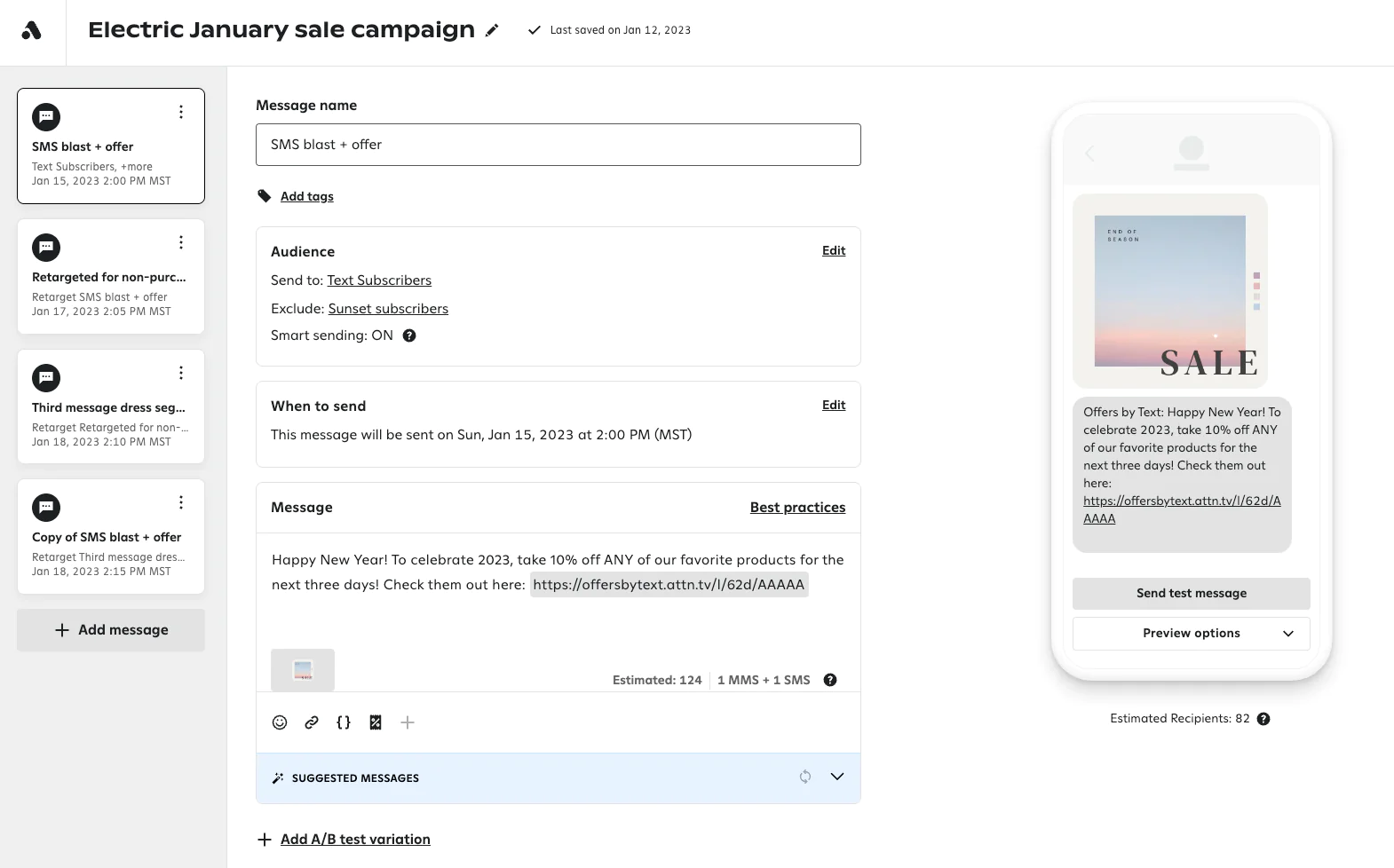
Attentive‘s Campaign Composer
Attentive also emphasizes compliance (automating things like “Text STOP to unsubscribe” and audit logs) to keep you on the right side of regulations. Simply put, if SMS is a big revenue driver for you, Attentive gives you a rich toolkit to maximize it.

Two-way messaging in Attentive
Klaviyo’s SMS came later but integrates tightly with its email. It’s very user-friendly to set up SMS in Klaviyo—you can collect phone numbers via Klaviyo forms, then include SMS steps in your flows. It covers the essentials: mass texting, segmentation, personalization (e.g. inserting a customer’s first name or a product they left in cart), and basic two-way (customers can reply and you’ll see it in Klaviyo, though it’s not a full chat management solution).
For many mid-size brands, Klaviyo SMS yields great ROI, particularly for cart reminders and flash sale alerts. It might not have fancy AI chatbot features like Attentive, but it hits the main use cases and benefits from being in the same system as your emails (consolidated analytics and easier coordination).
Maestra’s SMS is as feature-rich as Attentive’s in terms of sending capabilities—you can send personalized, segmented texts at scale, include short trackable links, run A/B tests on SMS content, etc.
What differentiates Maestra is how SMS is woven into the omnichannel logic. For example, Maestra can automatically suppress an SMS send if the customer just engaged via another channel, or conversely trigger an SMS if other channels fail to reach the customer. It treats SMS as one touchpoint in a holistic customer conversation.
Additionally, Maestra offers cross-device identification, so if a customer signs up with both email and phone, it knows it’s the same person—preventing duplicate messages.
In summary: Attentive = best-in-class standalone SMS solution (with concierge texting), Klaviyo = very good SMS that’s easy for e-com teams especially alongside email, Maestra = top-tier SMS that’s fully integrated into a broader engagement strategy.
SMS Winner: Maestra
This one is close, because Attentive is extremely strong in SMS, and a case could be made for it if we only consider SMS in isolation. Attentive’s focus and innovation in texting (especially two-way engagement) are industry-leading.
However, if we consider SMS as part of your overall marketing toolkit, Maestra wins by integrating SMS into omnichannel flows. Maestra gives you nearly all of Attentive’s SMS firepower plus the ability to have those texts coordinated with emails, push, and on-site actions in real time.
Klaviyo is no slouch either—it’s an approachable SMS option for those already using Klaviyo, though it doesn’t have the advanced conversation features of Attentive or the cross-channel intelligence of Maestra.
If you want the most effective use of SMS not just as a silo but as part of a unified customer journey, Maestra provides that broader context and control, making it the winner in this comparison.
Attentive vs Klaviyo vs Maestra: Website & Email Product Recommendations
Attentive
Klaviyo
Maestra
⭐
No native recommendation engine. You should manually choose products to promote in your messages or integrate a third‑party tool
No native recommendation engine. You should manually choose products to promote in your messages or integrate a third‑party tool
⭐⭐
Basic built‑in product‑recommendation blocks for email. Klaviyo can pull products from your catalog to display in emails based on simple rules
Basic built‑in product‑recommendation blocks for email. Klaviyo can pull products from your catalog to display in emails based on simple rules
⭐⭐⭐⭐⭐
Full AI‑driven recommendation engine for both web and email. Analyzes behavior and product data to suggest items each shopper is likely to buy. Over a dozen pre‑built models (e.g., "Frequently Bought Together," "Trending Products," "Similar Items") that update in real time and significantly boost cross‑sell and upsell performance
Full AI‑driven recommendation engine for both web and email. Analyzes behavior and product data to suggest items each shopper is likely to buy. Over a dozen pre‑built models (e.g., "Frequently Bought Together," "Trending Products," "Similar Items") that update in real time and significantly boost cross‑sell and upsell performance
Attentive does not offer a built-in product recommendation feature. You can certainly promote products in your SMS or email campaigns, but Attentive won’t automatically choose those products for each user—you’d have to decide what to feature or rely on another system’s logic.
Klaviyo provides basic product recommendation blocks in emails. For example, you can drag in a “Recommended Products” section which might display items from the same category as the customer’s last purchase, or best-sellers from your store.
These rules are relatively simple and not AI-driven; they’re often based on either your overall popular products or simple co-purchase rules (“people who bought X also bought Y”). It’s useful, but not highly personalized to each individual’s unique behavior beyond their last interaction.
Enlightened Equipment Achieves 15% Website Conversion Growth with AI-Powered Product Recommendations
Maestra comes with a full AI-powered recommendation system that works on both your website and in emails. It uses machine learning models to analyze browsing history, purchase patterns, product attributes, and more to figure out what a given customer is likely to be interested in.
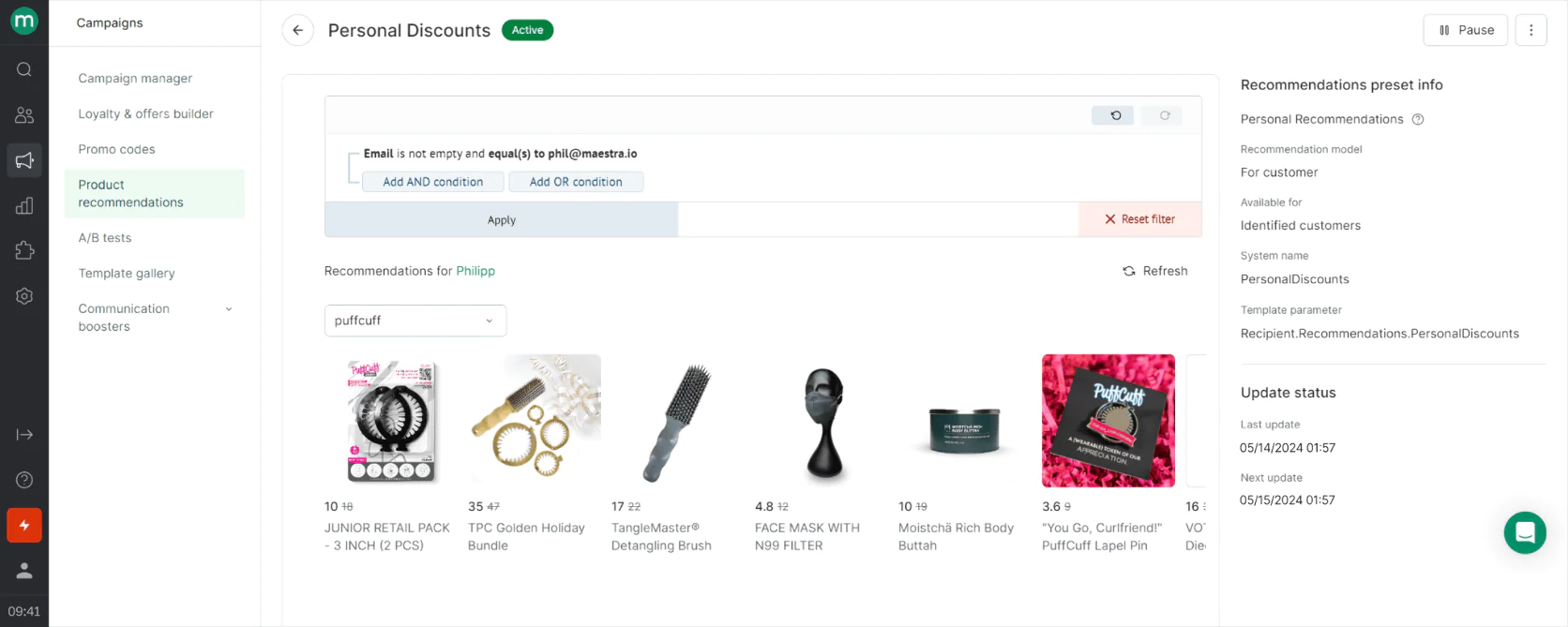
Personal product recommendations in Maestra
Maestra’s recommendations update in real time—so if a customer browses a category, the next set of recs might emphasize related items. You can choose different algorithms (most popular, trending, similar items, complementary items, new arrivals personalized to user, etc.) and even set manual rules if needed.
For email, Maestra can insert personalized product recommendations into newsletters or triggered emails automatically, which is a huge time-saver versus manually curating products. For web, Maestra can display dynamic recommendation carousels (e.g. “You might also like” sliders) to each visitor.
Bottom line: Attentive = no native rec engine, Klaviyo = basic rule-based recs in email, Maestra = advanced AI recs across channels.
Product Recommendations Winner: Maestra
For an e-commerce business aiming to maximize cross-sells and upsells, Maestra’s integrated AI recommendations are the most powerful option. It can significantly boost conversion by showing each shopper the products they are most likely to buy next, in real time.
Klaviyo’s simple recommendations are better than nothing and can add some value in emails, but they don’t learn and optimize in the way Maestra’s AI does.
Attentive doesn’t offer any help here at all (beyond what you manually set).
Thus, Maestra clearly wins on product recommendations—it’s the only one of the three with a true recommendation engine built-in.
Attentive vs Klaviyo vs Maestra: Promotions and Referrals
Attentive
Klaviyo
Maestra
⭐⭐
No built‑in referral module; promotion management is limited. You can send promo codes or “refer‑a‑friend” links via SMS/email, but Attentive doesn’t track referral logic—requires a separate tool
No built‑in referral module; promotion management is limited. You can send promo codes or “refer‑a‑friend” links via SMS/email, but Attentive doesn’t track referral logic—requires a separate tool
⭐⭐
Similar to Attentive. Can generate unique coupon codes via Shopify and automate promo messages, but does not track referral performance natively; relies on external apps
Similar to Attentive. Can generate unique coupon codes via Shopify and automate promo messages, but does not track referral performance natively; relies on external apps
⭐⭐⭐⭐⭐
Built‑in promotions & referrals engine. Configure programs (e.g., “refer a friend, both get $15”), generate and track codes/links, credit rewards, and automate follow‑ups across channels—no extra software needed
Built‑in promotions & referrals engine. Configure programs (e.g., “refer a friend, both get $15”), generate and track codes/links, credit rewards, and automate follow‑ups across channels—no extra software needed
Attentive and Klaviyo are primarily messaging tools, so their role is to deliver promo messages, while the e‑commerce platform or another app usually handles the logic.
Attentive can send unique coupon codes via SMS or email (it can integrate with Shopify to pull in discount codes, for instance). You can segment and target who gets an offer. But Attentive won’t track, say, how many people your customer referred or whether a coupon led to a purchase—you’d rely on Shopify or another system for that. There’s no dashboard in Attentive for referral program stats or anything; you’d just send out the invites.
Klaviyo similarly can generate and insert coupon codes into emails and can send emails nudging referrals (“Share this code with a friend!”), but Klaviyo does not track referrals or run a referral program natively. You’d need an external app to actually track who referred whom and who’s earned rewards.
In short, Klaviyo handles the messaging part of promotions well but not the program mechanics.
Maestra actually includes the ability to run referral programs and complex promotions internally. You can assign customers referral links or codes and Maestra will track who referred new customers and automatically reward them (e.g. credit points or give coupons when a referral purchase happens).
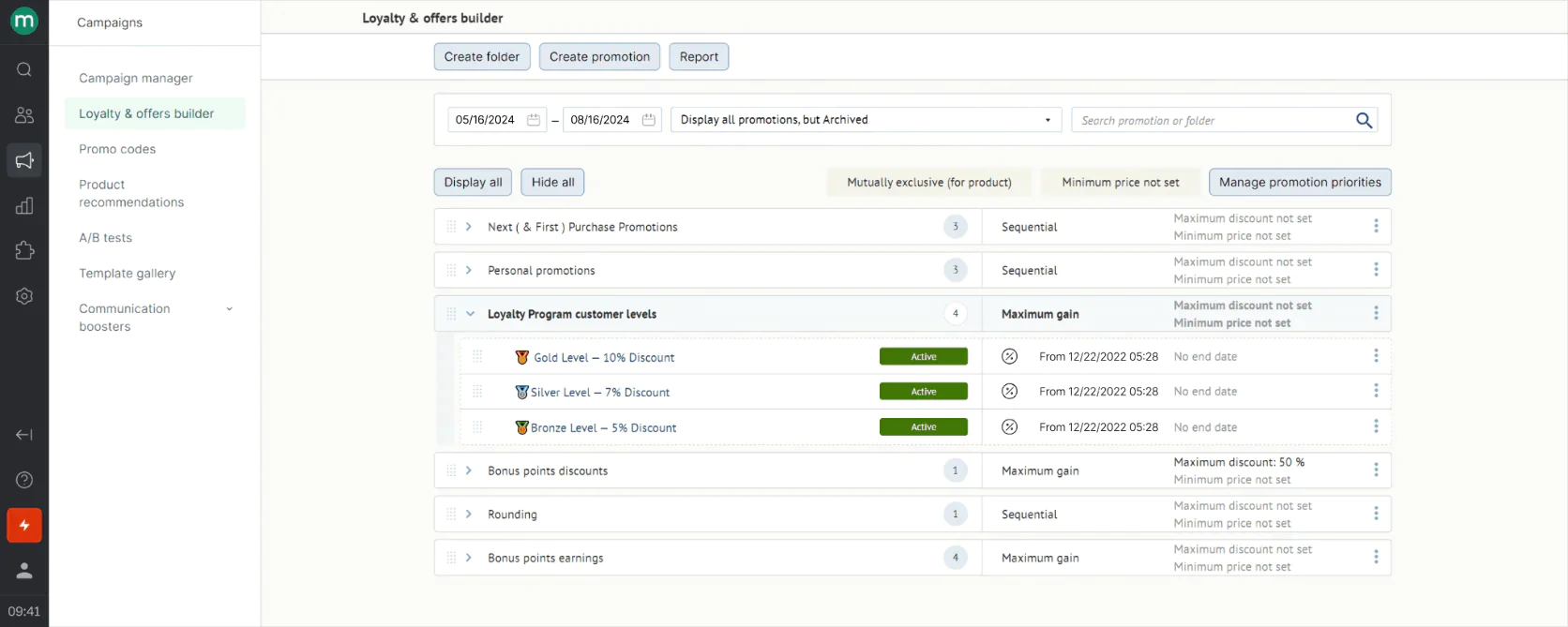
Maestra’s promotions rule engine
It also supports creating promotion rules, like “spend $100, get $20 off your next purchase” or “free gift with orders over $50 in the next 7 days.” These can be configured in Maestra and then communicated via all channels. Maestra thus closes the loop: it not only sends the promo messages but also tracks and triggers outcomes (like sending a reminder if a promo is unused).
This level of built‑in promotion management is something Attentive and Klaviyo lack.
Promotions & Referrals Winner: Maestra
Overall, Maestra clearly leads in promotions and referrals because it actually provides the tools to create and manage these programs, not just communicate them. If you want to run a referral campaign, Maestra can be your one‑stop shop—it assigns referral codes, tracks conversions, and follows up accordingly.
Attentive and Klaviyo would require you to manage that in another app and just handle the messaging. For a growing brand, consolidating promotions within Maestra means less setup hassle and better insight into performance. Maestra ensures that promo and referral initiatives tie directly into your customer profiles and omnichannel campaigns (e.g. auto‑reminding a customer about their unused referral reward via email/SMS).
Neither Attentive nor Klaviyo can do that natively, making Maestra the winner for this category.
Attentive vs Klaviyo vs Maestra: Loyalty Programs
Attentive
Klaviyo
Maestra
⭐
No native loyalty features—points, tiers, and reward tracking require a separate platform, with Attentive only sending loyalty updates via SMS/email
No native loyalty features—points, tiers, and reward tracking require a separate platform, with Attentive only sending loyalty updates via SMS/email
⭐
No native loyalty either. Can display loyalty data if synced from a third‑party app, but can’t run a loyalty program on its own
No native loyalty either. Can display loyalty data if synced from a third‑party app, but can’t run a loyalty program on its own
⭐⭐⭐⭐⭐
Comprehensive loyalty engine built‑in. Define earn rules, redemption options, tiered statuses (Silver, Gold, etc.), point expiry, and embed balances dynamically in campaigns—creating a holistic retention ecosystem
Comprehensive loyalty engine built‑in. Define earn rules, redemption options, tiered statuses (Silver, Gold, etc.), point expiry, and embed balances dynamically in campaigns—creating a holistic retention ecosystem
Attentive can assist a loyalty strategy only by messaging—for example, texting customers their points balance or sending VIP-exclusive offers—but that’s only if you feed Attentive the data from an external loyalty system. Attentive itself has no concept of points or tiers.
Klaviyo likewise has no native loyalty module. Many brands integrate a loyalty app (Smile.io, etc.) and then sync some data to Klaviyo (like a “Loyalty Tier” field or “Points” property for each customer) so Klaviyo can personalize emails with that info. But Klaviyo isn’t awarding points or calculating rewards.
Maestra includes a full loyalty program engine. It lets you define how points are earned (per dollar spent, maybe extra for product reviews or referrals) and how they can be redeemed (discounts, freebies, early access). It tracks customers’ point balances and status in tiers (e.g. Silver, Gold).
All of that data lives in Maestra’s customer profile. This means you can set up automated engagement like “when a customer hits VIP tier, send them a special SMS and apply a tag to give them free shipping”—entirely within Maestra.
Loyalty is not an afterthought; it’s a core component that works in tandem with campaigns (e.g. including point balances in emails or targeting high-point members with a double-points promotion).

Maestra’s Loyalty Program dashboard
Therefore: Attentive and Klaviyo rely on outside loyalty solutions, while Maestra can run loyalty in-house.
Loyalty Programs Winner: Maestra
For loyalty programs, Maestra is the clear winner by virtue of having the capability at all. Neither Attentive nor Klaviyo provides native loyalty management—if you need points and rewards, you must use an external tool with those platforms.
Maestra not only provides loyalty features, but integrates them with everything else (so your loyalty data and marketing data are one and the same). This allows far richer retention marketing: you can automatically engage customers based on their rewards and incentivize repeat purchases with precision.
In contrast, with Attentive/Klaviyo, your loyalty program would sit elsewhere and your communications might not be as tightly coupled to loyalty behavior.
So, Maestra wins by a landslide here for any brand that wants to build and grow a loyalty program as part of its marketing strategy.
Attentive vs Klaviyo vs Maestra: Mobile and Web Push Notifications
Attentive
Klaviyo
Maestra
⭐
No push support. For mobile or web push you’ll need another solution—Attentive focuses on SMS
No push support. For mobile or web push you’ll need another solution—Attentive focuses on SMS
⭐⭐⭐
Beta mobile‑app push (no web push). Works if you install Klaviyo’s SDK in your app; limited feature depth and no browser push
Beta mobile‑app push (no web push). Works if you install Klaviyo’s SDK in your app; limited feature depth and no browser push
⭐⭐⭐⭐⭐
Full mobile & web push integrated with other channels. Rich content (images, buttons), real‑time triggers, scheduling, and frequency caps—push is orchestrated inside omnichannel flows
Full mobile & web push integrated with other channels. Rich content (images, buttons), real‑time triggers, scheduling, and frequency caps—push is orchestrated inside omnichannel flows
Attentive does not support mobile or web push, as its focus is SMS.
Klaviyo only very recently started offering mobile push support. This allows you to include “Push” as an action in a Klaviyo flow (e.g. sending a push message via your app). It’s a welcome addition, but still limited.
Notably, Klaviyo does not do web browser push at this time.
Maestra offers both mobile and web push notifications as native channels in the platform. If you have a mobile app, Maestra’s SDK will enable you to send rich push notifications (with images, buttons, etc.) to those app users. If you don’t have an app, you can still use web push: Maestra can prompt visitors on your site to allow notifications, then send them browser-based push messages for things like back-in-stock alerts or promotions.
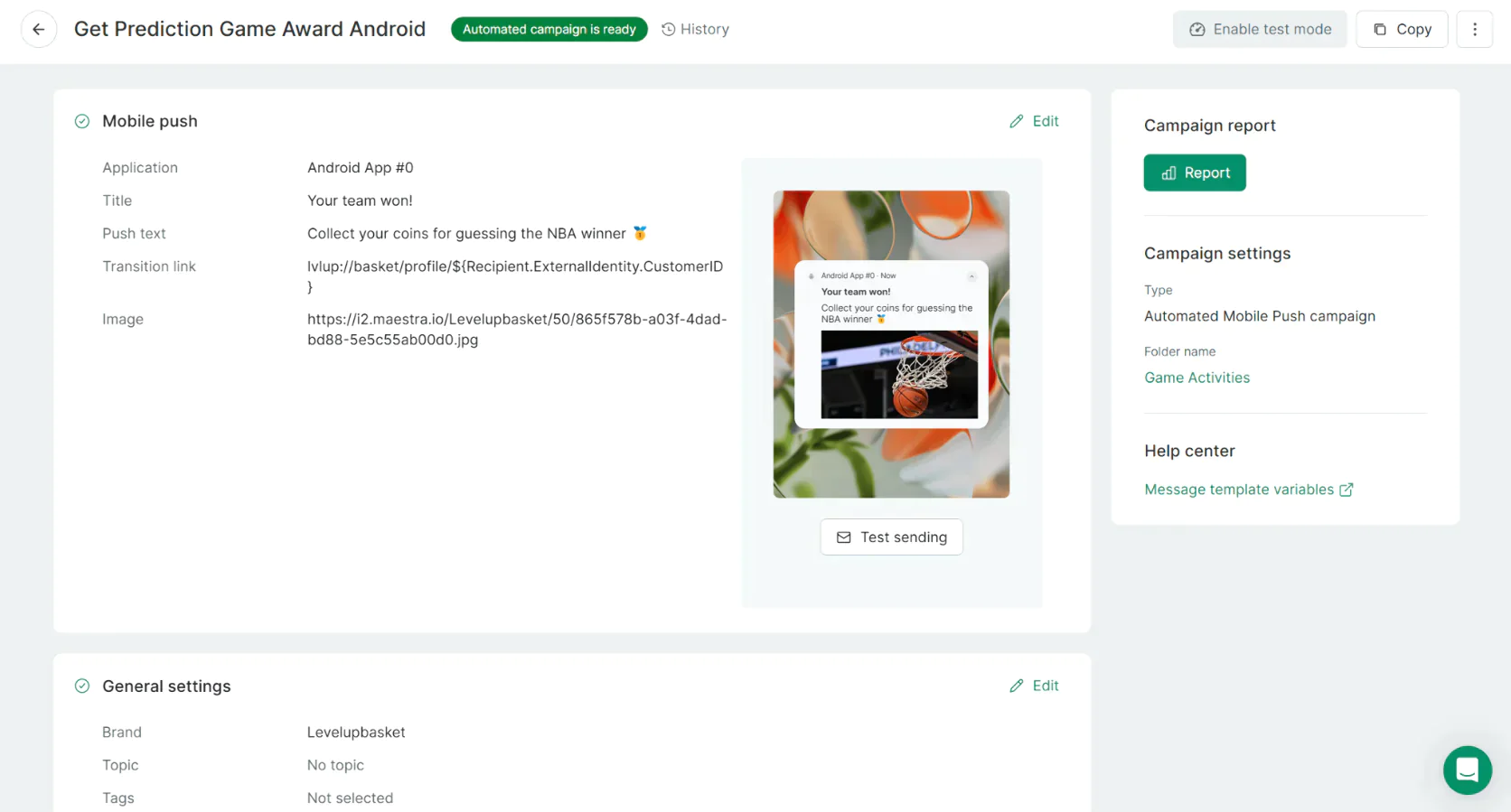
Maestra’s mobile push builder
The key advantage is that push in Maestra is fully integrated into the omnichannel journey—you can decide whether to reach someone via push versus email or SMS based on their behavior, and Maestra will coordinate it.
It also provides scheduling controls and frequency caps. So you can, for example, ensure you don’t hit someone with an email and a push at the exact same time, or you send a push only if they didn’t open the email.
In short: Attentive = no push, Klaviyo = basic mobile push (no web) in beta, Maestra = comprehensive push capabilities across mobile/web aligned with other channels.
Mobile & Web Push Notifications Winner: Maestra
Maestra offers the broadest push notification support. It’s the only one of the three that can handle both mobile and web push as part of your marketing toolkit.
We’ll note that Klaviyo has made strides by adding mobile push, but it’s still limited and lacks web push entirely.
Attentive doesn’t support either, focusing instead on text messaging.
Therefore, for a marketer who wants to add push notifications into their engagement strategy (especially without relying on yet another vendor), Maestra is the winner here. It provides push as a first-class channel, similar to how an enterprise platform like Braze would.
Attentive vs Klaviyo vs Maestra: Ad Optimization
Attentive
Klaviyo
Maestra
⭐⭐
Basic audience exports; no automated, real‑time sync or suppression lists—advanced targeting needs custom work
Basic audience exports; no automated, real‑time sync or suppression lists—advanced targeting needs custom work
⭐⭐⭐⭐
Direct Facebook/Google audience sync keeps segments up to date for retargeting and lookalikes; still requires building ads in those platforms
Direct Facebook/Google audience sync keeps segments up to date for retargeting and lookalikes; still requires building ads in those platforms
⭐⭐⭐⭐⭐
Dynamic, behavior‑triggered audience sync to major ad networks. Removes converted users in real time, leverages predictive scores, and treats ads as another orchestrated channel—minimizing wasted spend
Dynamic, behavior‑triggered audience sync to major ad networks. Removes converted users in real time, leverages predictive scores, and treats ads as another orchestrated channel—minimizing wasted spend
Attentive doesn’t have native features to optimize ads. You can manually use its data. For example, you might export a list of SMS subscribers or create a Zapier to feed new subscribers into Facebook Ads as a custom audience.
There’s no one-click “sync segment to Facebook” in Attentive’s interface as far as standard features go.
Klaviyo does have direct integrations for advertising—notably with Facebook and Google.
In Klaviyo, you can choose a segment and enable Facebook Audience Sync, which will continuously push that segment to Facebook Ads Manager. Many Klaviyo users love this because you can, say, have a segment of high spenders and ensure your Facebook ads exclude them (to save budget) or target them with cross-sell ads.
Same with Google Customer Match—Klaviyo can automatically upload emails/phones to Google for targeting on Search/YouTube.
This essentially turns Klaviyo into a light CDP feeding your ad platforms with better audiences.
Maestra goes a step further by making ad audience management an automated part of your marketing. It can not only sync segments to Facebook/Google like Klaviyo does, but do so dynamically based on behavior triggers. For instance, Maestra could automatically add a customer to a suppression list on Facebook the moment they make a purchase (so they stop seeing prospecting ads).
Essentially, Maestra treats ad networks as another “channel” to optimize—your customer segments flow out to ads in real time, and you can coordinate messages (e.g. don’t show an ad to someone who just redeemed a promotion on email).
While Klaviyo’s integration is excellent, Maestra’s is more real-time and event-driven, closing the loop in ways only more enterprise systems typically do. Attentive, being SMS-first, hasn’t focused on this kind of ad integration.
Ad Optimization Winner: Maestra
Focusing on feature breadth, both Klaviyo and Maestra offer direct integration with ad platforms for audience syncing—a key ad optimization feature. They enable better retargeting and lookalike campaigns by leveraging customer data.
However, Maestra takes the win because it automates these optimizations at a granular level (instant audience updates, behavior-triggered adjustments), whereas Klaviyo’s sync, while very useful, operates on a more static schedule.
Attentive is behind in this area, lacking built-in audience sync tools.
So, if maximizing ad ROI by syncing and updating audiences is a priority, Maestra provides the most advanced solution, with Klaviyo a close second as a solid, if slightly less dynamic, option.
Attentive vs Klaviyo vs Maestra: Reporting & Attribution
Attentive
Klaviyo
Maestra
⭐⭐⭐
Straightforward SMS/email reports (sends, clicks, revenue). Primarily last‑click, single‑channel attribution; limited multi‑touch insights.
Straightforward SMS/email reports (sends, clicks, revenue). Primarily last‑click, single‑channel attribution; limited multi‑touch insights.
⭐⭐⭐⭐
Robust e‑commerce dashboards showing revenue by flow/campaign, CLV metrics, flexible attribution windows—focused on email/SMS impact.
Robust e‑commerce dashboards showing revenue by flow/campaign, CLV metrics, flexible attribution windows—focused on email/SMS impact.
⭐⭐⭐⭐⭐
Unified, multi‑channel analytics with control‑group testing. Tracks retention, order frequency, loyalty redemption, and offers multi‑touch attribution across all channels in one place.
Unified, multi‑channel analytics with control‑group testing. Tracks retention, order frequency, loyalty redemption, and offers multi‑touch attribution across all channels in one place.
Attentive offers straightforward campaign-level reporting for SMS and email. You can see how many texts were sent, delivered, clicked, and even revenue from each campaign if you integrate with your store (using something like a conversion tracking pixel or attribution window). It’s good for answering “what did this SMS blast yield?”
Attentive also allows basic A/B testing and can show lifts in conversion for those tests.
However, Attentive’s reporting is confined to the channels it manages—it doesn’t do multi-channel attribution or holdout testing by itself.
Klaviyo has pretty rich e-commerce focused analytics. Its dashboard will show overall attributable revenue from Klaviyo, broken down by flows and campaigns. It uses mostly last-touch attribution for purchases—meaning if an email was the last thing clicked before a sale, it gets credit. You can adjust attribution windows (e.g. credit an email if a purchase happens within X days of clicking it).
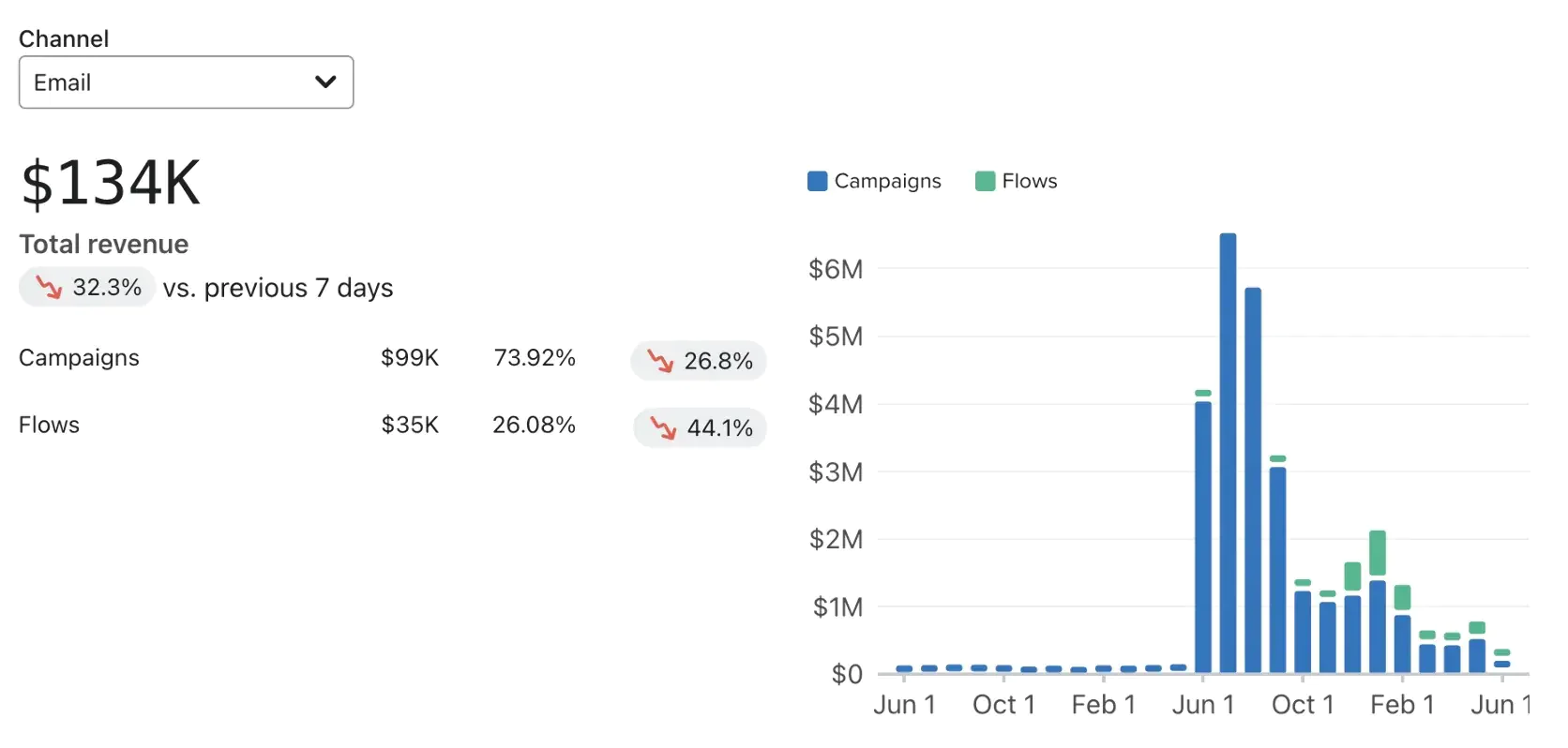
Fragment of Klaviyo’s business review dashboard
Klaviyo also displays trends like repeat purchase rate, average order value over time, etc., which are handy for marketers. It even has a cohort analysis for CLV.
Maestra provides a unified view of all marketing impact since all those channels run through it. In Maestra, you can see how a customer journey that touched email, SMS, and loyalty contributed to a purchase.
It supports creating control groups for campaigns to measure true lift (so you can see if sending that win-back series actually increased sales compared to not sending).

Maestra’s campaigns report
Maestra’s attribution is more flexible—you can see the influence of multi-channel campaigns on a sale.
It also rolls up higher-level metrics: for example, it can tell you overall retention rate changes after implementing a loyalty program, because it tracks loyalty and purchase data together.
Essentially, Maestra gives you the kind of reporting that typically would require exporting data to a BI tool—but built-in. If you have unique metrics or reports, you can always export the data from Maestra to analyze elsewhere, but many businesses find the built-in dashboards sufficient.
Summing up: Attentive = basic channel-specific reporting, Klaviyo = strong email/SMS-centric ecom reporting (with revenue attribution to those campaigns), Maestra = comprehensive cross-channel reporting.
Reporting & Attribution Winner: Maestra
Maestra provides the most holistic reporting because it spans all channels (and even loyalty) in one place. You’re able to measure the customer experience end-to-end and truly understand marketing ROI across touchpoints. It offers advanced features like holdout tests and multi-channel flows analysis that the others don’t natively support.
Klaviyo’s reporting is very good within its scope—many marketers rely on it to see exactly how much revenue their email and SMS campaigns generate. For a small/mid business, that might be enough. But as you venture into more channels and want to attribute, say, a sale that involves an email, an SMS, and a Facebook ad, Klaviyo alone won’t give you that—Maestra will.
Attentive, while fine for SMS metrics, is the least capable in advanced attribution.
Thus, Maestra wins for marketing analytics depth, with Klaviyo second for solid e-comm campaign reporting, and Attentive third.
Attentive vs Klaviyo vs Maestra: Customer Support
Attentive
Klaviyo
Maestra
⭐⭐⭐⭐
High‑touch for top‑tier clients (dedicated AM); smaller accounts rely on tickets/knowledge base—can feel slower
High‑touch for top‑tier clients (dedicated AM); smaller accounts rely on tickets/knowledge base—can feel slower
⭐⭐⭐
Solid documentation, email support, live chat for paid users, active community; dedicated CSM only at enterprise level
Solid documentation, email support, live chat for paid users, active community; dedicated CSM only at enterprise level
⭐⭐⭐⭐⭐
White‑glove support for every client: named CSM, proactive strategy sessions, rapid responses, assistance with migration and campaigns
White‑glove support for every client: named CSM, proactive strategy sessions, rapid responses, assistance with migration and campaigns
Attentive positions itself as a high-service provider—their sales pitch often highlights a “consultative” approach and they do assign CSMs (customer success managers) to larger clients. Many Attentive users praise their onboarding assistance. That said, there have been mixed experiences: some smaller customers report slower response times and a more transactional support experience (likely because they don’t have a dedicated rep).
Essentially, Attentive’s support is tiered by your size: big spenders get white-glove treatment; SMBs get standard support (email/tickets and help center resources).
Klaviyo’s support is largely self-service oriented. They have an excellent help center and community forum, which answer most common questions. If you need help, Klaviyo offers email support to everyone and live chat to paying customers. They also have onboarding specialists for new customers (especially if you migrate from another system).
However, they do not typically assign you a dedicated success manager unless you are an enterprise client with a very large contract. Many small businesses use Klaviyo with zero direct contact with Klaviyo’s team—and generally do fine because the product is user-friendly and documentation is good. However, if an issue arises or you need strategic advice, you might be largely on your own or have to wait in a support queue.
Maestra is on the opposite end: it provides hands-on support to every client. From the moment you sign on, you get a named CSM who is your go-to for everything—training, strategy, troubleshooting. They often do weekly or monthly check-ins proactively. Because Maestra’s price point includes this service, they make sure you’re leveraging the platform fully.
This can be a game-changer for teams that don’t have a lot of technical or marketing operations resources in-house. If you’re used to other SaaS tools where you file a ticket and wait days, Maestra’s speedy responses and willingness to actually do custom solutions for you (like helping build an integration or campaign) stands out.
In short: Attentive = good support if you’re big, adequate if you’re small; Klaviyo = reliable basic support but DIY ethos; Maestra = high-touch support for all.
Customer Support Winner: Maestra
For Customer Support, Maestra clearly offers the most hands-on, personalized support for all customers. They treat every client like a VIP, which is especially valuable for mid-market brands that need guidance to execute advanced campaigns. Attentive and Klaviyo both have support, but it’s a tiered/differentiated approach.
Unless you’re a large Attentive client or on Klaviyo’s highest tier, you won’t get a dedicated strategist from those platforms. Maestra includes that by default. This means with Maestra you’re not only getting software, you’re getting a partner who will help you use it optimally. Many scaling e-commerce teams would benefit from that level of help, making Maestra the winner in support.
Klaviyo’s robust documentation and community are great—and Attentive will certainly help via tickets or an AM—but neither can match Maestra’s white-glove service model.
Attentive vs Klaviyo vs Maestra: Integration Capabilities
Attentive
Klaviyo
Maestra
⭐⭐⭐⭐
Strong core e‑commerce integrations and APIs, but fewer one‑click partners than Klaviyo; custom work may be needed for niche tools
Strong core e‑commerce integrations and APIs, but fewer one‑click partners than Klaviyo; custom work may be needed for niche tools
⭐⭐⭐⭐⭐
Hundreds of pre‑built integrations (Shopify, WooCommerce, Recharge, Gorgias, etc.) plus Zapier and open API—fits easily into most stacks
Hundreds of pre‑built integrations (Shopify, WooCommerce, Recharge, Gorgias, etc.) plus Zapier and open API—fits easily into most stacks
⭐⭐⭐⭐⭐
Covers major systems natively; if not pre‑built, Maestra’s team assists in building custom connectors, ensuring any integration is possible—often reducing total tools needed
Covers major systems natively; if not pre‑built, Maestra’s team assists in building custom connectors, ensuring any integration is possible—often reducing total tools needed
Attentive integrates well with the e-commerce basics: it has plug-and-play integrations with Shopify, BigCommerce, Magento, etc., so you can get your customer and order data flowing in. It also offers APIs and webhooks for custom integrations.
Many Attentive users rely on its API to feed event data or to export data to a warehouse for analysis. Attentive’s partner ecosystem is growing, but it’s not as extensive as Klaviyo’s yet; you might find fewer third-party apps with a direct “Attentive integration” (for example, an ESP or loyalty app might integrate with Klaviyo but not Attentive, requiring more custom work on Attentive’s side).
Klaviyo has one of the richest integration libraries in the e-commerce marketing space. On their website, they list 300+ integrations covering everything from e-commerce platforms, CRM, help desks, review apps, loyalty apps, subscription billing, shipping tracking, to even data pipelines.
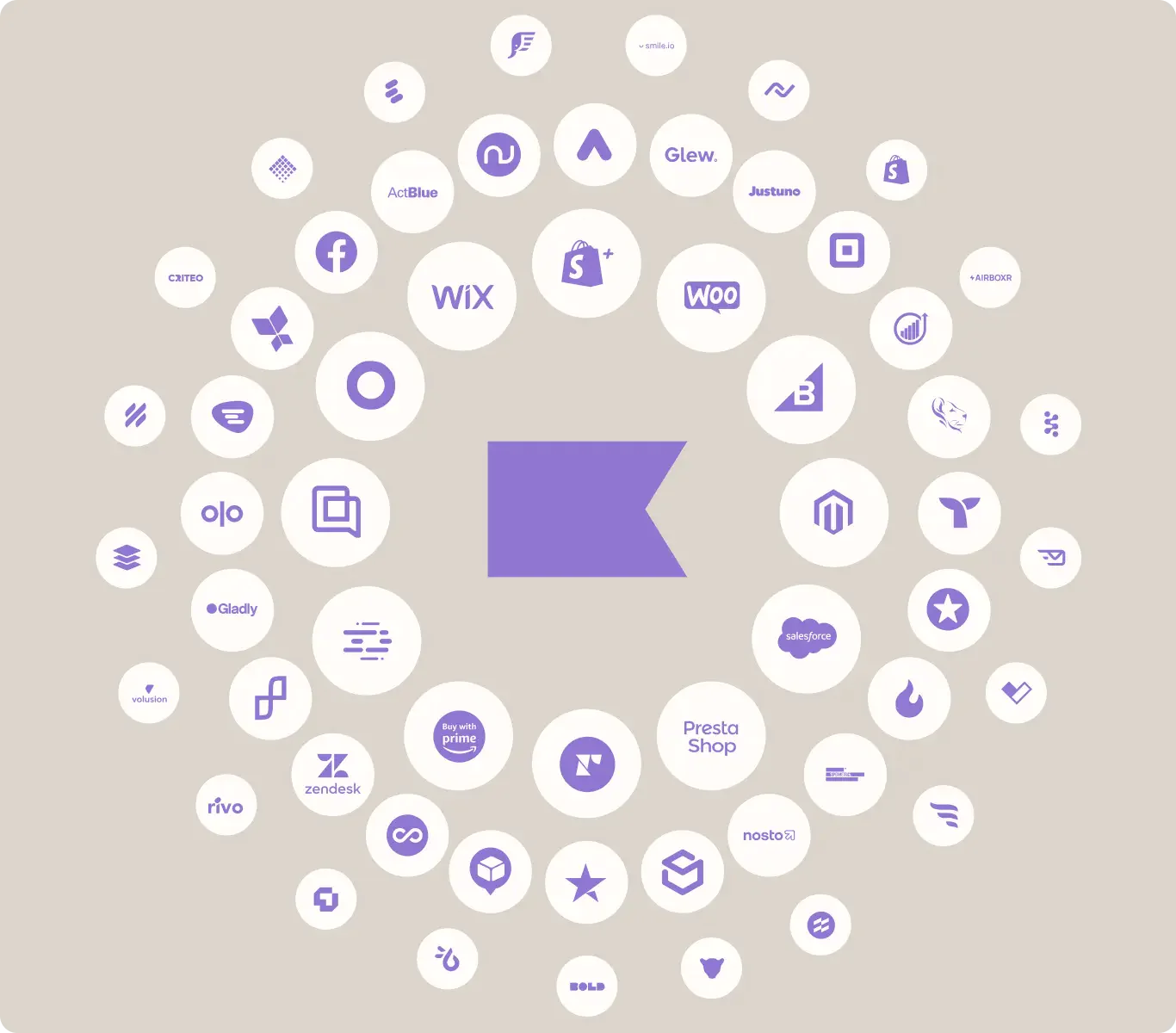
Many of these are very easy to connect—often just entering an API key or clicking connect via OAuth. It’s a huge plus for not having to involve developers.
Maestra has focused integrations for e-commerce as well—they cover the must-haves (Shopify, Magento, BigCommerce, payment processors, popular review/UGC tools, etc.).
Because Maestra can potentially replace other tools (like loyalty or email), you might find you need fewer integrations overall.
But inevitably, there will be systems to connect (maybe your ERP or a custom database). Maestra’s approach is that if a native integration doesn’t exist, their team will actively help build a solution using their API/webhooks. This is fairly unique—instead of you figuring it out alone, Maestra works with you to ensure data flows right. They also monitor those connections (making sure the sync runs, etc.).
In practice, Klaviyo likely has more “out-of-the-box” integrations readily available given its ecosystem, but Maestra covers the bases and compensates by offering custom integration support. Attentive is somewhere in between; it covers standard e-com needs and has an API for the rest, but you may need a developer to connect some dots that Klaviyo might have done with a pre-built plugin.
Integration Capabilities Winner: Klaviyo and Maestra
This is a close call between Klaviyo and Maestra. Klaviyo wins on sheer number of easy pre-built integrations—it’s unlikely you’ll find a popular e-com tool that Klaviyo doesn’t already connect with. For a plug-and-play stack, Klaviyo is fantastic.
Maestra wins on flexibility and support—even if an integration isn’t pre-built, Maestra will help make it happen. It’s essentially “we’ll integrate with anything, one way or another.” For many mid-size brands, that hands-on approach is as good as a huge app marketplace.
Attentive, while solid for core integrations, doesn’t quite match the breadth of Klaviyo’s library or the bespoke assistance of Maestra.
So we’ll call Klaviyo and Maestra joint winners here: Klaviyo for its vast, user-friendly integration ecosystem, and Maestra for ensuring all your data sources can connect either natively or via custom solutions (with help included).
Attentive vs Klaviyo vs Maestra: Educational Resources
Attentive
Klaviyo
Maestra
⭐⭐⭐⭐
Resource Hub, blogs, webinars, compliance guides; smaller community, no formal academy, but ample SMS best‑practice content
Resource Hub, blogs, webinars, compliance guides; smaller community, no formal academy, but ample SMS best‑practice content
⭐⭐⭐⭐⭐
Extensive Klaviyo Academy, live trainings, annual conference, huge community forum, deep help center—ideal for self‑serve learning
Extensive Klaviyo Academy, live trainings, annual conference, huge community forum, deep help center—ideal for self‑serve learning
⭐⭐⭐⭐⭐
Comprehensive knowledge base plus personalized training from your CSM—combines documentation with ongoing 1‑on‑1 coaching
Comprehensive knowledge base plus personalized training from your CSM—combines documentation with ongoing 1‑on‑1 coaching
Attentive provides useful content like how-to guides (especially around SMS marketing best practices), an SMS gallery of examples, and frequent blog posts about texting strategies. They also host webinars and publish compliance guides (since SMS has legal rules).
However, Attentive doesn’t have a formal user community or certification program that we’re aware of—it’s a bit more of a top-down learning approach (they’ll advise you via their team or through their guides). For many users, the resources Attentive offers are sufficient to get going and learn SMS tactics, but it’s not as community-driven as Klaviyo’s resources.
Klaviyo is renowned for its educational ecosystem. The Klaviyo Academy provides structured courses on everything from beginner setup to advanced segmentation. They have live training sessions, tons of on-demand videos, and even certifications. There’s also the Klaviyo Community Forum where tens of thousands of users discuss questions—often you’ll find your question already answered there.
Klaviyo’s blog and documentation are exhaustive (if sometimes a bit scattered just due to volume). Additionally, they hold an annual user conference and local workshops, which fosters a strong community of practice. Basically, if you prefer self-service learning or networking with peers, Klaviyo is excellent.
Maestra provides a lot of guidance too, but via a more personalized approach. They have a knowledge base with articles and best practices for omnichannel campaigns. But the standout is that Maestra includes personalized training through its CSMs.
That means if you need to learn how to implement something, you can hop on a call with your success manager who will walk you through it step by step, tailored to your actual setup. Maestra might not have as many public-facing tutorials or a huge user forum (being newer and more niche than Klaviyo), but they compensate by basically tutoring each client individually. For a team that doesn’t have time to sift through docs, that’s ideal.
In summary: Attentive has good content but less formal training; Klaviyo has a vast array of self-serve educational materials and community; Maestra has thorough documentation plus hands-on training via their service team.
Educational Resources Winner: Klaviyo and Maestra
Klaviyo is known for its user-friendly learning resources and community, which is hard to beat. The wealth of tutorials, the active forum, and programs like Klaviyo Academy make it very accessible for marketers to level up their skills. If you like to learn by yourself or get certified, Klaviyo provides that in spades.
Maestra also ensures you learn the platform, but through a more concierge model—every Maestra client essentially gets one-on-one training via their CSM. That’s incredibly valuable, especially for busy teams, but it’s a different style of education.
Attentive is fine here, but not distinguished—you’ll learn SMS mainly through their provided guides and your CSM if you have one, without the broader community or course offerings that Klaviyo has.
Attentive vs Klaviyo vs Maestra: Pricing
Attentive
Klaviyo
Maestra
Custom, premium. Requires quote; platform fee + per‑SMS charges. Costs climb with list growth; budget carefully, especially if SMS isn’t primary revenue driver
Transparent, pay‑as‑you‑grow. Free tier up to 250 contacts; cost scales by contact count & SMS volume. Predictable but can get pricey at very large lists
Profile‑based, premium. Starts around $2,990/mo for 80k profiles with all channels & support included—replaces multiple tools, no message caps
Attentive operates on a quote-based pricing model with usage components. Typically, Attentive charges a platform fee (which may include a certain number of SMS messages) plus overage or per-message fees. They don’t publish a standard price table—you have to talk to sales for a custom quote.
Many factors might influence the cost: your number of contacts, monthly message volume, and any services included. Attentive is generally considered premium-priced for the SMS space; smaller brands have noted that costs can escalate as their list grows, sometimes prompting them to look for cheaper alternatives.
On the flip side, Attentive often negotiates and will sometimes match or beat competitors’ pricing to win deals. For planning purposes, you might start around a few hundred dollars a month at minimum for modest volumes, and into the thousands per month for larger sends.
Importantly, because SMS itself has a hard cost per message (carrier fees), any SMS platform will get more expensive as you scale—Attentive’s added value is the service and platform on top of that, which is what you pay a premium for.
Klaviyo is very transparent: they have a free tier (up to 250 contacts for email, and up to 50 SMS contacts with 150 SMS credits) to get you started.
After that, pricing scales by the number of contacts for email and by SMS message volume for SMS. For example, if you have 10,000 contacts and you’re emailing them, you’ll pay a certain amount per month for email (maybe around $150/month for 10k contacts; their pricing page has exact brackets).
If you also send SMS, you purchase SMS credits; U.S. SMS might be about $0.01 per message, so you either pay as you go or buy a package. The nice part is you can adjust your plan month to month (it’s all self-serve billing).
Klaviyo’s pricing can become significant as you grow (e.g. 100k contacts email+SMS can run into thousands per month), but you always know the cost structure upfront and can budget accordingly. There are no annual contracts required unless you choose one for maybe a slight discount. Many small businesses appreciate the “pay as you grow” model with no surprises.
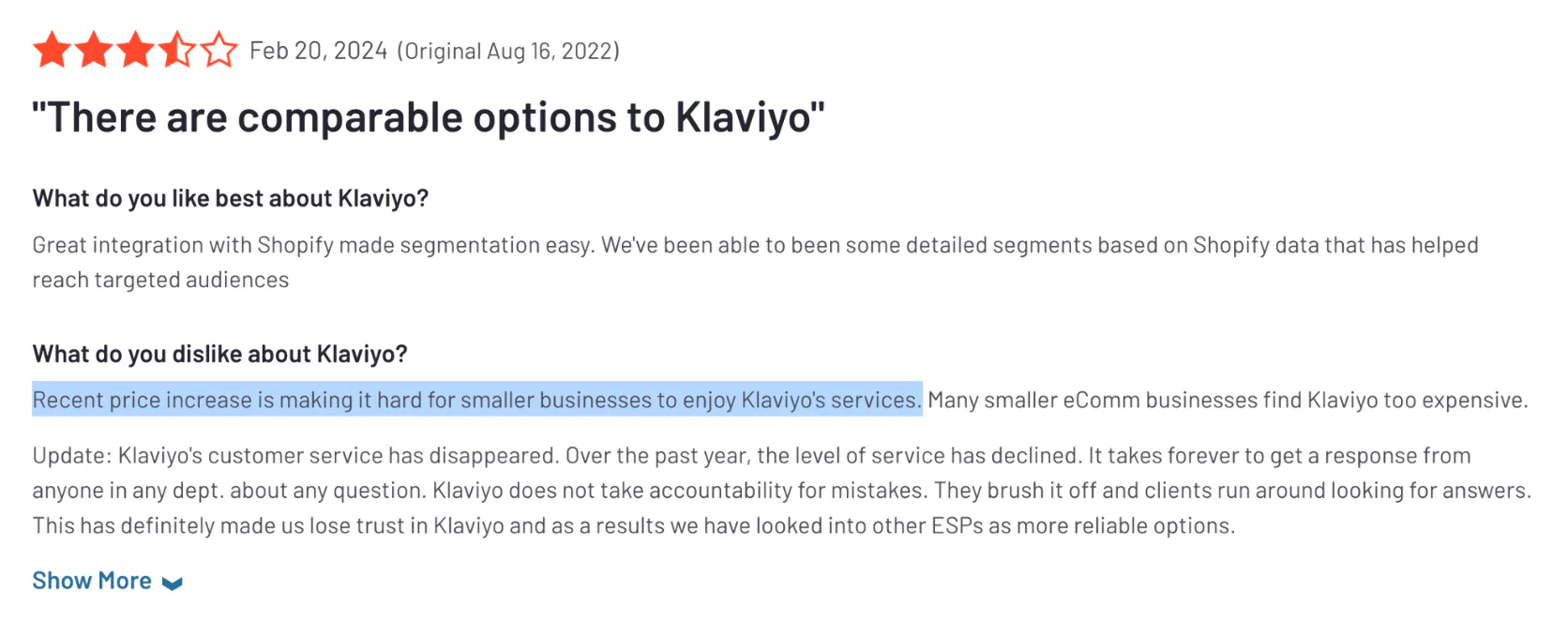
Maestra uses a profile-based pricing model with tiers. They start around $2,990 per month for up to 80,000 customer profiles. A profile is basically a unique customer record in their CDP.
Pricing then scales if you need more profiles (for instance, the next tier might cover 150k profiles at a higher rate, etc.). All features—email, SMS, push, loyalty, etc.—are included in that price. Maestra does not have a free tier or self-service monthly plans; it’s a higher-end investment that usually involves committing for a year (with the ability to grow your allotment as needed).
While $2k+ per month is a big jump from Klaviyo’s entry pricing, consider that Maestra aims to replace multiple tools (email service, SMS platform, maybe your loyalty software, site personalization tool, etc., plus it includes the dedicated support). For a mid-size brand consolidating tools, the total cost might be comparable or even less than paying for many separate apps.
The good thing is Maestra’s pricing is simpler in that you’re not counting emails or messages—you have freedom to engage your 80k profiles across channels as much as needed, which can encourage more robust marketing without worrying about per-email costs.
In summary: Attentive’s cost is custom and can be on the higher side for heavy SMS usage (with less transparency), Klaviyo’s cost is transparent and scalable for growing businesses (though can add up at large volumes), Maestra’s cost is a significant fixed investment that bundles a lot of value (software + support + multi-tool consolidation).
Final Verdict: Attentive vs Klaviyo vs Maestra
Let’s summarize the best use cases for each platform:
Attentive
Attentive is a powerhouse for brands that prioritize SMS marketing and want a hands-on partner for that channel. It’s best for companies that have seen strong results from texting and are willing to invest in a premium SMS platform to maximize that channel’s revenue.
For example, a retail brand with a large SMS list and a focus on text message sales could choose Attentive for its advanced SMS features (like conversational texting) and guidance on SMS strategy. Attentive can drive impressive engagement via text—flash sale alerts, back-in-stock texts, personalized offers—and it excels at compliance and deliverability for SMS.
However, Attentive may be overkill or too narrow for businesses that need a broader multichannel approach. It doesn’t cover channels like on-site personalization, push, or loyalty, so you’ll still be piecing together other tools if you need those.
Also, Attentive’s pricing can become quite steep as you scale, which might be hard to justify if SMS isn’t your main revenue driver.
In short, choose Attentive if SMS is your main focus (and you maybe have another solution for email or don’t mind Attentive’s basic email) and you want top-notch execution and support for texting. If SMS is just one part of your strategy or you’re very cost-sensitive as you grow, you might find Attentive’s limitations and cost frustrating in the long run.
Klaviyo
Klaviyo is the go-to choice for small and medium e-commerce businesses for good reason. It’s tailor-made for online stores and provides a quick ramp-up for both email and SMS marketing.
If you’re just starting to build out your email list or text program, Klaviyo offers an intuitive interface and pre-built templates that can have you sending effective campaigns literally the same day you install it. The Shopify (and other platform) integration means your store data is instantly available to drive segmentation and automation—so things like a welcome series, cart abandonment flow, etc., are almost plug-and-play.
For a brand that primarily needs to improve their email/SMS marketing and basic segmentation, Klaviyo is hard to beat on simplicity and ROI. Many brands happily stick with Klaviyo through the mid-growth stage because it covers a lot (email, SMS, basic forms) without needing extra tools.
It’s also reasonably affordable at first and scales predictably with your business.
That said, as your marketing strategy becomes more advanced, you might hit some limits with Klaviyo: it doesn’t do on-site personalization or loyalty or advanced cross-channel journeys. You may end up integrating additional tools (for loyalty, for site pop-ups beyond basics, for push notifications, etc.), which can create data silos.
Additionally, Klaviyo’s cost at very large contact counts can grow high (some large DTC brands with 1M+ contacts have noted Klaviyo’s bill can rival more enterprise platforms).
Essentially, Klaviyo is powerful until you need capabilities outside its wheelhouse. If email and SMS cover 90% of your marketing needs, you’ll be very happy with it for a long time. If you start wanting more channels integrated or more one-to-one personalization across every touchpoint, you’ll begin to see why more unified tools like Maestra exist.
Maestra
Maestra is the best choice for mid-sized and growing e-commerce brands that are ready to unify their marketing stack for the next level of personalization and scale. It’s perfect for a company that maybe has been using separate tools (Klaviyo for email, a loyalty app, a pop-up tool, an SMS tool, etc.) and is frustrated by the silos or lack of advanced capabilities when those tools aren’t fully in sync.
With Maestra, you get an all-in-one platform that does what Klaviyo does and much more, all leveraging the same real-time customer data. The benefit is huge: you can deliver the kind of tailored, consistent omnichannel experiences that only big enterprises with custom integrations (or someone combining Attentive + Klaviyo + other add-ons) could typically do—but without needing a big tech team, because Maestra handles the heavy lifting.
Additionally, Maestra’s white-glove support means even if your team is small, you can execute sophisticated campaigns with expert guidance on hand. In terms of cost, Maestra is a larger investment than Klaviyo (there’s no free tier; it’s a premium solution), but it often replaces multiple tools and their associated costs.
For brands that reach the point where they say, “We want to treat our customers uniquely across every channel and maximize retention via loyalty and personalization,” Maestra offers that in a unified way without the patchwork of plugins and integrations.
Essentially, choose Maestra when personalized, omnichannel retention marketing becomes a top priority and you’re ready to invest in a platform that can deliver it end-to-end.
Begin your journey with Maestra—schedule a demo today and discover how it can transform your business operations.
